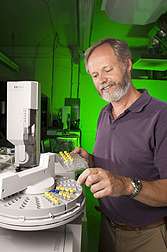Citrus root signals produce better biocontrol

Substances released into the soil by citrus tree roots when chewed on by insect pests could lead to new ways of improving the effectiveness of roundworm "first responders."
Substances released into the soil by citrus tree roots when chewed on by insect pests could lead to new ways of improving the effectiveness of roundworm "first responders."
That's the implication of studies by a team of U.S. Department of Agriculture (USDA) and University of Florida (UF) scientists who identified several citrus chemicals, including terpenes, which attract Steinernema riobrave, Heterorhabditis indica and other beneficial nematode species that prey on citrus root weevils.
Upon encountering the weevil's grub-like larvae, the nematodes wriggle inside and feed on the pests internally, killing them 24-48 hours later. The nematodes' reduction of grub numbers can range from 0 to 90 percent, depending on soil type, temperature and other factors.
Until recently, little attention has been paid to the complex chemical tete-a-tete that occurs between citrus roots, feeding grubs and the soil's resident nematodes, according to chemist Hans Alborn with USDA's Agricultural Research Service (ARS) and Jared Ali and Lukasz Stelinksi—both with UF's Citrus Research and Education Center in Lake Alfred, Fla. ARS is USDA's principal intramural scientific research agency.
In lab and greenhouse studies with small trees derived from the commercial rootstock "Swingle citrumelo," roots damaged by captive grubs attracted up to three times more S. diaprepesi nematodes than roots that had been mechanically damaged or left intact. An analysis of root volatiles released by the trees showed that terpenes accounted for four of six nematode-signaling compounds.
Interestingly, the roots only released the compounds when being fed on by grubs, notes Alborn, with the ARS Chemistry Research Unit in Gainesville, Fla. The researchers have so far tested the signaling capacities of five citrus rootstocks, and hope to screen as many as 20 more by the end of 2011.
Eventually, the team hopes to recommend rootstock-nematode combinations that can be used in an integrated approach to managing the pest.
More information:
The research was published in the Journal of Chemical Ecology.
Read more about the research in the January 2011 issue of Agricultural Research magazine.
Provided by USDA Agricultural Research Service

















